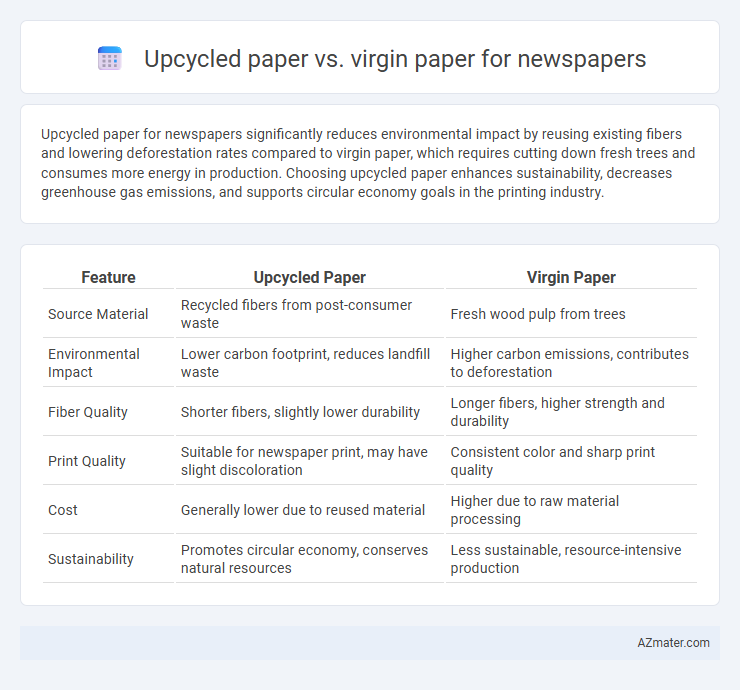Upcycled paper for newspapers significantly reduces environmental impact by reusing existing fibers and lowering deforestation rates compared to virgin paper, which requires cutting down fresh trees and consumes more energy in production. Choosing upcycled paper enhances sustainability, decreases greenhouse gas emissions, and supports circular economy goals in the printing industry.
Table of Comparison
| Feature | Upcycled Paper | Virgin Paper |
|---|---|---|
| Source Material | Recycled fibers from post-consumer waste | Fresh wood pulp from trees |
| Environmental Impact | Lower carbon footprint, reduces landfill waste | Higher carbon emissions, contributes to deforestation |
| Fiber Quality | Shorter fibers, slightly lower durability | Longer fibers, higher strength and durability |
| Print Quality | Suitable for newspaper print, may have slight discoloration | Consistent color and sharp print quality |
| Cost | Generally lower due to reused material | Higher due to raw material processing |
| Sustainability | Promotes circular economy, conserves natural resources | Less sustainable, resource-intensive production |
Introduction to Upcycled and Virgin Paper
Upcycled paper is manufactured by reprocessing previously used paper materials, reducing waste and conserving natural resources. Virgin paper, derived directly from fresh wood pulp, offers higher purity and strength but involves significant deforestation and energy consumption. In newspaper production, upcycled paper promotes sustainability while virgin paper ensures superior print quality and durability.
Environmental Impact: Upcycled vs Virgin Paper
Upcycled paper for newspapers significantly reduces deforestation by reusing existing fibers, lowering the demand for virgin pulp sourced from trees. This process decreases energy consumption and water usage by up to 50% compared to virgin paper production, minimizing greenhouse gas emissions and landfill waste. Choosing upcycled paper supports sustainable forestry practices and lowers the overall environmental footprint of newspaper publishing.
Resource Consumption in Production
Upcycled paper production for newspapers significantly reduces resource consumption by reusing existing fibers, lowering water and energy usage compared to virgin paper made from fresh wood pulp. Virgin paper manufacturing demands large quantities of timber, causing higher deforestation rates and greater environmental impact due to intensive processing. Opting for upcycled paper supports sustainable resource management and reduces the carbon footprint associated with newspaper production.
Quality and Printability for Newspapers
Upcycled paper for newspapers offers a sustainable alternative with moderate print quality, but it often contains fibers that can reduce smoothness and brightness compared to virgin paper. Virgin paper, made from fresh wood pulp, provides superior opacity, brightness, and surface strength critical for high-resolution images and sharp text in newspaper printing. Printability on virgin paper ensures consistent ink absorption and drying, resulting in clearer, more vibrant newspapers ideal for mass distribution.
Cost Analysis: Comparing Expenses
Upcycled paper significantly reduces raw material costs in newspaper production by reusing fiber from waste paper, whereas virgin paper involves higher expenses due to fresh pulp extraction and processing. Energy consumption for upcycled paper is typically lower, contributing further to overall cost savings compared to the energy-intensive process required for virgin paper production. While upcycled paper may incur additional expenses in deinking and sorting, the total cost is generally more economical for large-scale newspaper printing.
Carbon Footprint and Sustainability
Upcycled paper in newspapers significantly reduces carbon footprint by reusing fibers, cutting down on energy consumption and greenhouse gas emissions compared to virgin paper production, which relies on fresh timber and intensive pulping processes. Sustainability is enhanced with upcycled paper as it limits deforestation and conserves water resources, promoting circular economy principles. Virgin paper's environmental impact includes habitat loss and higher carbon emissions, making upcycled alternatives a preferred choice for eco-friendly newspaper printing.
Supply Chain and Material Sourcing
Upcycled paper for newspapers relies heavily on post-consumer waste, reducing the demand for fresh wood fibers and decreasing the environmental impact of raw material sourcing. Virgin paper requires a significant supply chain investment in timber harvesting, pulping, and chemical processing, often involving longer lead times and higher energy consumption. Supply chain efficiency for upcycled paper benefits from localized recycling systems, whereas virgin paper supply chains depend on global forestry operations and extensive transportation networks.
Reader Perception and Preference
Readers often perceive upcycled paper as more eco-friendly and sustainable compared to virgin paper, influencing their preference towards environmentally responsible brands. Surveys reveal that a significant portion of newspaper audiences prioritize recyclability and reduced environmental impact when choosing their news sources. Despite slight differences in texture and print quality, upcycled paper's benefits in reducing deforestation and carbon footprint increase its appeal among environmentally conscious readers.
Recycling Challenges in the Newspaper Industry
Upcycled paper in newspapers presents recycling challenges due to fiber degradation, which reduces print quality and durability compared to virgin paper sourced directly from trees. Contaminants like ink and adhesives complicate the recycling process, increasing costs and requiring advanced deinking technologies to maintain paper integrity. The newspaper industry's reliance on high-quality fibers leads to a preference for virgin paper to meet print standards and recyclability requirements.
Future Trends in Newsprint Paper Choices
Upcycled paper is gaining traction in the newsprint industry due to its environmental benefits and reduced production costs compared to virgin paper derived from fresh timber. Advances in recycling technology are improving the print quality and durability of upcycled newsprint, making it a competitive alternative for publishers aiming to meet sustainability goals. Market forecasts indicate a rising demand for eco-friendly paper options, driven by stricter environmental regulations and growing consumer preference for green products in media.

Infographic: Upcycled paper vs Virgin paper for Newspaper
 azmater.com
azmater.com